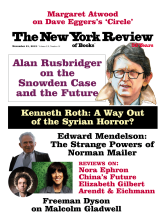In response to:
'After May,' What? from the July 11, 2013 issue
To the Editors:
I am a subscriber, so I almost fell from my chair when I bumped into Luc Sante’s piece “‘After May’ What?” [NYR, July 11]. I am very grateful for the unexpected honor of having my work reviewed in a magazine I hugely respect. I nonetheless need to correct a factual mistake that ultimately has the author misreading the very meaning of my film.
When he describes the final scene in Something in the Air (Après Mai), Luc Sante refers to a “brief dream sequence projected in a theater as if it were a commercial, with a voice-over drawn from that text [Debord’s].”
This is not it. Gilles walks into an “experimental cinema night” at the Electric in Portobello—in the early Seventies this was a commercial-free zone. And there he sees, well…an experimental film, starring his lost love, and muse, Laure. She is now dead. And she may have appeared in that film when she was in London, the previous summer.
For Gilles, it is an epiphany. He finally understands what cinema (or art) is about: reviving the past, resurrecting the dead, making (higher) sense of what’s lost. Up to that point he had been attracted to movies, but without exactly knowing what they really meant for him. Here, he finally grasps that they deal with some sort of metaphysics, that they speak directly to him, and echo his most intimate wounds. He finally understands that through that art he can try to reach whatever his teenage idealism was naively pointing to.
That is something militant filmmaking could not embody, or the film industry, as Gilles experiences it in his short internship in a British studio. This is something that can only be embodied by whatever idealism is at the root of independent filmmaking. Which is—not so obviously, it seems—my point.
There is no voice-over. Only a Kevin Ayers song, “Decadence,” which says:
She lies in waterfalls of dreams
And never questions what it means.
And all along the desert shore
She wanders further ever more
The only thing that’s left to try
She says to live I have to die.
So, Laure lives again in art.
I suppose it also echoes the final chapter in my essay where I try (in my own idiosyncratic way) to put the practice of cinema into the perspective of creating situations in the sense early Situationism used that word in the late Fifties (and not later).
Answering, I hope, the question “After May,” What?: well, for me, life.
PS: An English translation of my essay “Une adolescence dans l’après-Mai” was published earlier this year by the Vienna Filmmuseum under the title “A Post-May Adolescence.”
Olivier Assayas
Paris, France
Luc Sante replies:
I’m sorry that in my haste I relied on another critic’s account of the voice-over, which I couldn’t remember when I wrote my review. I must say that I’m disappointed, though; a voice-over taking its text from Debord might have introduced more interesting contradictions into the scene than the Ayers lyric, which merely illustrates the image.



